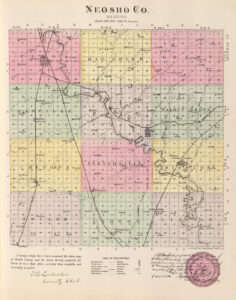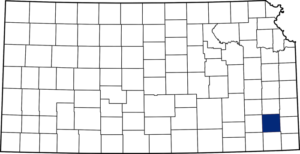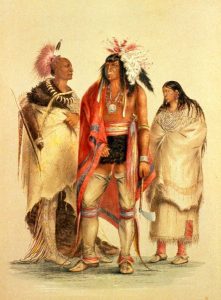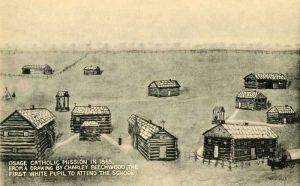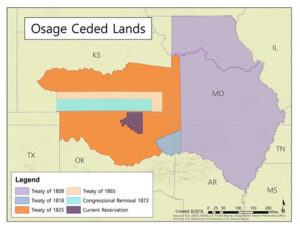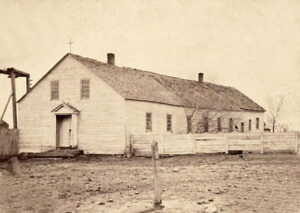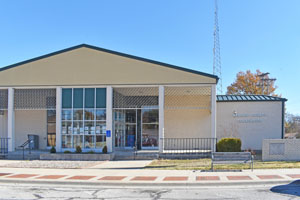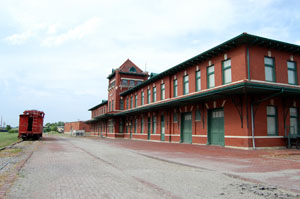Towns & Places:
Chanute
Erie – County Seat
Galesburg
St. Paul & the Osage Catholic Mission
Stark
Thayer
Extinct Towns of Neosho County
Neosho State Fishing Lake
Neosho County, Kansas, is located in the Southeast part of the state. It is named for the Neosho River, which passes through the county. The county seat is Erie. As of the 2020 census, the county population was 15,904.
It is located in the second tier of counties from Missouri and the second tier from Oklahoma to the south. It is bounded on the north by Allen County, on the east by Bourbon and Crawford, on the south by Labette, and the west by Wilson County.
The general surface of Neosho County was a gently undulating prairie, with about 20% bottomland. This bottomland, along the Neosho River, averaged over two miles in width, and along the smaller streams, was about a quarter to half a mile wide. There was an abundance of native timber and many groves of artificial forest, including cottonwood, elm, hickory, hackberry, maple, oak, pecan, and walnut. Weibly Bluff, about three miles northwest of Erie, is about 80 feet high, and Ditmas Bluff, in Tioga Township, is about 75 feet high. The highest land in the county is in Shiloh Township and does not exceed 150 feet in height above the level of the Neosho River.
All portions of the county were fertile and produced excellent crops. Coal underlined about 10% of the area and was found mainly in Chetopa Township near Thayer. The vein was about 18 inches thick, and the coal was of good quality. The most significant amount mined in a single year (1876) was about 100,000 tons.
The Neosho River, the principal stream, enters from the northeast and flows southwest through the county. Its principal tributaries are Rock, Canville, and Big Creeks. Superior-quality limestone and sandstone were abundant. A stone resembling black marble was also found near Erie. Brick clay was plentiful.
The Osage tribe inhabited the area long before Kansas became a territory. The first missionary was Reverend Charles de la Croix, who arrived in May 1822 and established the Osage Mission. Two years later, La Croix died, and he was succeeded by Reverend Charles Van Quickenborn, who, in 1828, performed the first Christian marriage ceremony in the state.
In the early 1820s, the Osage wished for and requested schools. Attempts were made, but were not successful. In 1847, two manual labor schools, one for boys and one for girls, were established by the Jesuits and the Loretto Sisters at Osage Mission, now known as St. Paul.
Edward Chouteau and Gerald Papin established Trading posts among the Osage in 1837. A half-breed settlement was established between Canville and Flat Rock Creeks. A.B. Canville, for whom the creek was named, started a trading post among the Indians in 1844, married the following year, and settled on Canville Creek in 1847. The first church and first school buildings were erected there in 1847.
By the laws of the Bogus Legislature, the area now included within the limits of Neosho County was part of Dorn County, which was established in 1855. The first post office was established at the Catholic Mission in 1856.
On June 3, 1861, the name of Dorn County was changed and became the counties of Neosho and Labette.
During the Civil War, Neosho County played its part in furnishing soldiers for the front. However, she also had considerable trouble of her own with border raids and depredations of various sorts. The Osage Indians, who were being taught farming, faced much discouragement, including guerrilla attacks that destroyed their crops and newly built houses by raiders who also drove off their livestock. Most of the Osage people supported the Union cause during the Civil War.
The county was organized in November 1864, with Governor Thomas Carney appointing three commissioners: R.W. Hadden, S.E. Beach, and S.W. Hadden. The county seat was declared at Roger’s Mills, located three miles northeast of the present city of Chanute. The first election for county officers was held in December 1864 and resulted as follows: Commissioners, R.W. Jackson, S.W. Hadden, T.Jackson; clerk, J.L. Fletcher; treasurer, William Jackson; surveyor, S. Jackson; county attorney, Darius Rodgers; probate judge, H. Woodard; sheriff, B. Vaughn; coroner, W.H. Davis; assessor, Wiley Evans; superintendent of public instruction, S.E. Beach.

Kansas Indian Reserves, about 1855.
The Osage tribe ceded their land in the Treaty of Canville in 1865. Afterward, the settlers believed that the “Osage Ceded Lands” were open to settlement, and 144 people made claims based on this understanding. This complication in land titles would create a great deal of trouble in the next few years.
In 1867, the county seat was located at the geographical center of the county. The first term of the District Court was held at Old Erie in September 1867. Honorable W. A. Spriggs of Garnett was the presiding Judge. T.C. Cory was appointed by Judge Spriggs as County Attorney and acted in that capacity throughout the term. T.J. Brewer was Clerk of the Court, and the lawyers in attendance from Neosho County were J.C. Carpenter, B.P. Ayers, Tom Bridgens, and C.F. Hutchings.
In 1868, elections were held, and factional feelings ran very high. Life-long enemies were made, and business was sacrificed in the struggle. Erie was declared successful by the commissioners. Court proceedings were brought to compel a recount of the vote, which was done in 1870 when it was found that Osage Mission had the majority. Considerable excitement was caused when the county records were stolen from Erie and taken to the Mission. They were never found, and the county lost several thousand dollars in the incident. No legal proceedings were brought to regain them, as Erie regained the county seat, and the people there were willing to let it pass.
The Methodist Church was organized in the spring of 1868, with 15 members, by Reverend T. Palmer, the first regular preacher. In 1872, the Methodists purchased a nearly completed church building.
When President Andrew Johnson declared a sale of the Osage lands in May 1868, the Missouri, Kansas & Texas Railway Company came forward claiming every other section for ten miles on each side of its road, according to a grant approved by the President of the United States in 1866, and the Leavenworth, Lawrence & Galveston Railroad made a similar claim according to a grant of Congress in 1863. Joseph S. Wilson, the commissioner of the General Land Office, repeatedly refused the claims of the railroads. However, Secretary of the Interior, O.H. Browning, reversed his decision, and the lands were withdrawn from sale. Fearful that they would be deprived of their homes and be obliged to buy from the railroad companies at high prices, the citizens formed an organization in 1868 known as the “Osage Settlers’ Rights Society,” through which they worked to get legislation on their behalf.
The first newspaper published in Neosho County was the Neosho Valley Eagle. This paper was started at Jacksonville on May 2, 1868, by B.K. Land and moved to Erie on October 24, 1868. On March 22, 1869, it was purchased by Kimball & Burton, enlarged from a six-column to an eight-column folio, and the name was changed to the Dispatch. J.A. Trenchard became editor on December 9, 1870. J.A. Wells became editor of the paper on February 24, 1871, and changed the name to the Erie Ishmaelite. The paper’s publication was suspended on June 2, 1871, and the office materials were purchased and relocated to the Osage Mission by J.H. Scott and H.T. Perry, who used them to publish the Neosho County Journal.
In 1869, Congress allowed bona fide settlers to buy any of the Osage ceded lands, but the act also protected “vested rights.” A question arose as to what “vested rights” were. The matter was taken to court, even involving Congress. In 1870, the U.S. Supreme Court ruled in favor of the settlers.
C.F. Stauber organized the Christian Church at his house in the spring of 1869. The society began erecting a church in 1872. Still, on account of the building of the railroads in the eastern and western parts of the county, the members mostly moved away to railroad towns, leaving Mr. Stauber practically alone. He sold the building to the Methodists in 1874 to save it from going to ruin. They completed, seated, and painted it.
The Baptist Church was organized in 1869 with seven members by Elder A.C. Bateman, who was chosen as the pastor. After the organization, services were held at the Erie Schoolhouse until a frame church building was erected in 1871 for $1,500.
The Neosho County Agricultural Society was organized on April 24, 1869, and the first fair was held on October 22 and 23.
The Mission Mills were located on Flat Rock Creek, about a mile east of Osage Mission. The two-and-a-half-story frame building stood above a stone basement story. These mills were built by Ryan & Roycroft in 1869 at a cost, including machinery and power, of $22,000. They were sold in 1875 to the First National Bank of Parsons, and this bank sold them in 1877 to Hutchings & Barnes. The machinery consisted of four runs of buhrs, with a capacity of 100 barrels of flour per day, and was propelled by a 50-horsepower engine. There was an elevator in the upper part of the building, which could store 20,000 bushels of wheat. The market for these mills’ products was driven by local demand in the Indian Territory (Oklahoma) and Texas.
A second line of the Missouri, Kansas & Texas Railway, built in 1870, entered on the north line, ran in a southeasterly direction, and crossed the southern line near the center.
The greatest crime ever committed in the county was by a gang of seven men at Ladore on the night of May 19, 1870. The gang took possession of the town, robbed several of the citizens, fired their revolvers at others, and then went to the house of I.N. Roach and beat him with clubs and revolvers until they saw him dead. They then took out two young daughters and, after stationing guards to prevent interference, repeatedly outraged them. During the commission of the crime, a quarrel arose among them, and one of them shot a comrade dead. In the morning, an alarm was given, and a party was organized that pursued and captured six of the fiends and hanged five of them to a hackberry tree near Labette Creek, all of whom, with the one that was shot, were buried in one grave. The one who was not hanged was named Peter Kelly; the one shot was Robert Wright, and the five hanged were William Ryan, Patrick Starr, Patsey Riley, Richard Pitkin, and Alexander Mathews. About 300 of the best citizens of the county were engaged in or were present at the lynching.
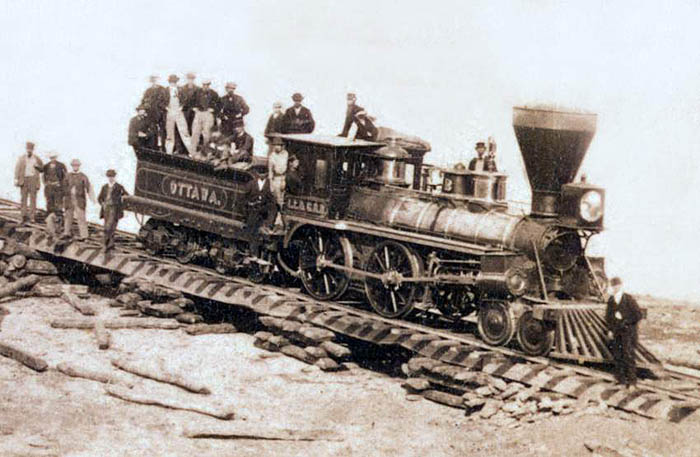
Leavenworth, Lawrence, & Galveston Railroad Locomotive, 1867.
The first railroad lines built through the county were the Leavenworth, Lawrence & Galveston and the Missouri, Kansas & Texas Railway in 1870. The latter road’s line entered the county on the east, crossing the line about two miles north of the center, and ran in a southwesterly direction, crossing the southern line about three miles east of the center. The stations on this line were St. Paul and South Mound.
The first school was taught in New Chicago (Chanute) in the winter of 1870 and was held in a private building that had been rented and fitted up for school purposes. The rapid increase in the school population soon demanded increased school facilities. In early 1871, steps were taken to erect a school building. That year, a handsome, two-story brick structure was built, containing four large schoolrooms that comprised five departments: the high school, grammar school, intermediate, second intermediate, and primary. These are under a corps of five efficient teachers. The building cost $15,000 in district bonds.
The first bank was established in Osage Mission by Pierce & Mitchell in April 1871. It was subsequently organized under State law as the Neosho County Saving Bank, with an authorized capital of $100,000 and a paid-up capital of $20,000. In August 1876, J. B. Pierce sold his interest in the concern to E.W. Bradbury, and the firm became Mitchell & Bradbury. The firm failed in February 1879. At this time, J.B. Pierce established the City Bank. It is a private institution engaged in a general banking exchange, loan, and collection business. It is also a bank of deposit.
In 1872, another election was held, but no choice was made. A few days later, another election was held to settle the matter. On the face of the returns, Erie received the most votes. Charges of fraud led to litigation, which was settled in 1874 by the Supreme Court in favor of Erie. Afterward, the first Neosho County courthouse was constructed.
The Osage Mission Stone Mill was built in 1875 by A.W. Althouse. It was a small stone structure 30 feet long by 20 feet wide and one and a half stories high. It contained three runs of stone and could grind 70 bushels of wheat and 100 bushels of corn daily. The motive power was a 20-horsepower engine.
The Neosho County Record was established in Erie by George W. McMillin on April 21, 1876. The material used had formerly been part of the office of the Thayer Headlight. The name “Headlight” was continued at Erie until May 5, 1876, when “Record” was substituted.
The Neosho County Bank was started by C.C. Nelson in March 1881, with S.F. Denison as cashier. This concern lasted only 40 days, until Nelson abandoned the business and took up residence as a British subject in the Dominion of Canada.
In the spring of 1882, the county’s population was estimated to be 16,000. There were 97 school districts and the same number of schoolhouses. The total number of students was 4,579, with 104 teachers employed. The value of the school property was $142,700.
The Atchison, Topeka & Santa Fe Railroad, built in 1883, crossed the county line, and the Neosho River, just north of Chanute, passed through that city, proceeding in a southeasterly direction through Erie and out on the east line of the county.
Oil and natural gas were discovered in 1885 while drilling for coal at Osage Mission. Because the gas was not considered valuable, the first wells were not taken into account.
The third line of this system was built by the Kansas Pacific Railroad in 1886. It crossed the southern line about two miles east of the center and ran northeasterly, leaving the county near the northeast corner. The total mileage of the two systems in the county was 123.
Because of the occasional overflow of the Neosho River and its branches, it was necessary to construct levees along the banks of the streams. These levees were begun in 1890 by private enterprise. When it was found that, although rude in construction, they protected the wheat fields from submersion, legislation was secured in 1893 to authorize public officials to build levees from public funds. The cost of this protection was about $5 per acre, and the value of protected lands increased from $10 to $20 per acre. The benefit of a sanitary point is also a significant consideration.
In 1897-98, after more oil wells were found, the Standard Oil company built a pipeline, which sparked an interest in the industry.
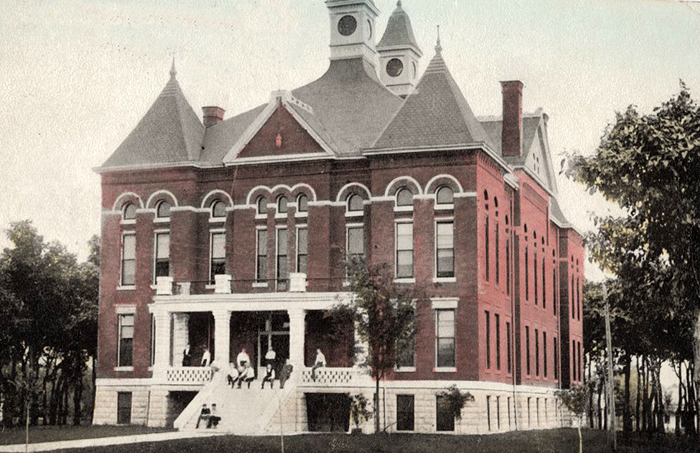
Neosho County Courthouse in Erie, Kansas, 1904.
A second courthouse, built in 1904 of brick and native stone, has a central cupola surmounted by towers with four round windows each. It was constructed by Dannelly & Halfin and designed by George P. Washburn & Son.
In 1910, there were over 100 organized school districts, and the school property was valued at about $200,000. In the same year, 24 rural mail routes emanated from the different towns in the county, and several entered from other counties, so the country’s people were well-supplied with daily mail.
At that time, 252,000 acres were under cultivation, with farm produce amounting to about $2,500,000, of which corn, the most valuable crop, contributed $500,000; oats, $150,000; and wheat, $100,000. Other leading field crops are Irish potatoes, flax, Kafir corn, and prairie grass. Animals sold for slaughter in 1910 brought $500,000. The assessed property valuation was nearly $30 million, and the population was 23,754, a gain of 4,500 over 1900.
Neosho County’s population peaked in 1920 at 24,000 and has gradually declined since then.
From 1961 to 1962, a new Neosho County Courthouse was built in the Modern style in Erie, Kansas. Facing west, the one-story building was constructed of cream-colored brick and glass with a peaked roof extending from the entrance to the east. Six square columns support the entrance, partially enclosed in glass. The old courthouse was razed after the present structure was completed.
According to the U.S. Census Bureau, the county has a total area of 578 square miles, of which 571 square miles is land and 6.3 square miles is water.
Neosho County has several properties listed in the National Register of Historic Places and the Register of Historic Kansas Places. The Osage Mission infirmary, built in the 1870s, was part of the St. Francis Institute, which the Jesuits founded. Nearby was St. Ann’s Academy, started by the Loretto sisters. It was in their possession until the 1890s, when it was given to the Passionists. The building was moved in 1912. The Chanute Public Library is a Carnegie library from around 1906.
©Kathy Alexander/Legends of Kansas, updated April 2025.
Also See:
Sources:
Blackmar, Frank W.; Kansas: A Cyclopedia of State History, Vol I; Standard Publishing Company, Chicago, IL 1912.
Cutler, William G; History of Kansas; A. T. Andreas, Chicago, IL, 1883.
Duncan, L. Wallace; History of Neosho and Wilson Counties, Kansas, Monitor Printing Co., Fort Scott, Kansas, 1902.
Kansas Memory
Kansas Post Office History
Wikipedia
Wikipedia – 2


